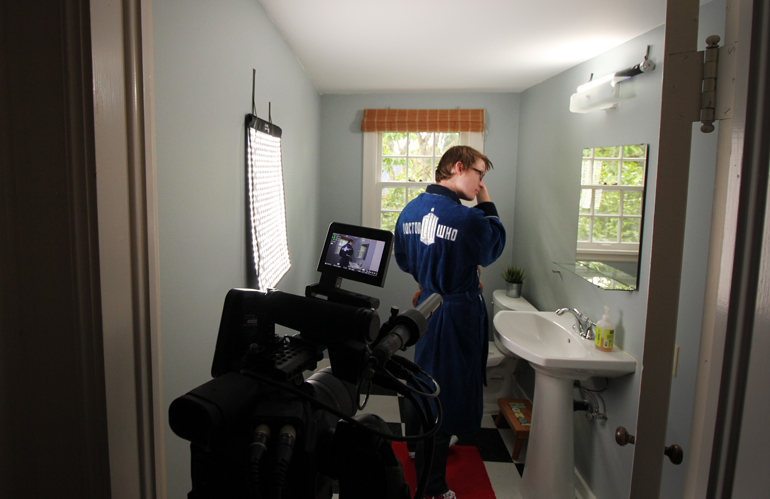Flexible LED Lights
Remember the first time you heard about a flexible LED panel light? You were probably a little bit impressed, or maybe even enthralled. So now that flex lights have been around for a few years, why hasn’t every videographer or documentary filmmaker on the planet bought into them?
Imagine, an LED light that has the power and color quality as an industry standard Litepanels 1x1, but weighs mere ounces, is thin enough to be rolled up or lay as flat as a magazine, is flexible and can be shaped to fit around tight spaces, and is durable enough to be used outdoors in the rain.
TL;DR: Genuine Flex Lights are amazing, but they're still costly and missing a few key features that would make them worth getting. However, more affordable Chinese-made flex lights are now widely available, and we recommend the Soonwell FB-215 for videographers who want to general purpose bi-color flex light today.
Our recommended flex light hanging on a wall
If you’ve ever carried around one of the original Litepanels 1x1 lights, you know how beastly they were. And once you added a V-lock battery on the backplate, you had a piece of heavy metal on top of a travel light stand. And for a simple interview shoot, you probably needed two or three of them.
Nowadays, we have a lot more options to choose from when it comes to LED panels. We have small, but powerful LEDs like the TorchLED Bolt that can be made into a large panel with a portable softbox, we have LED Fresnels like the Aputure COB 120D that are compact yet powerful interview lights when used with a scrim or umbrella, and we have extremely lightweight plastic panels like the Aputure Amaran lights, which offer a lot of power at the expense of durability.
But if you want a solid, dependable 1x1, you’re still looking at heavy duty housing. Even the widely popular Aputure Light Storm LS1S, for example, is still about 11 pounds with all its fixings, plus the battery.
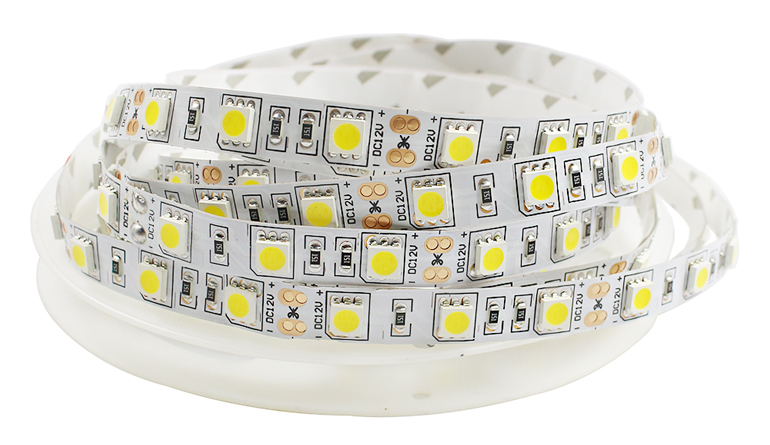
If you’ve ever seen LED strips on their own, you’ll wonder why it takes that much heavy metal to support a ribbon of LED bulbs that weigh no more than the ribbon you tie your birthday gifts with.
Sure, there is heat management, power supply, on-board dimming or color tuning, plus extras like a yoke, barn doors, battery tray, wireless dimming control, and general damage protection.
But what would happen if you placed a few strips of LED ribbon on a soft backing, and wired all the dimming and power to a remote unit?
That’s exactly what the Flex Light set out to become. First introduced to a small professional filmmaking audience by Korean manufacturer Aladdin, called the Flexlite 1, it was then adapted by Westcott into the Flex Mat and marketed toward a much larger market. And although many who own one have raved about it, you still don’t see a lot of Flex lights out there being used by everyday videographers. Why is that?
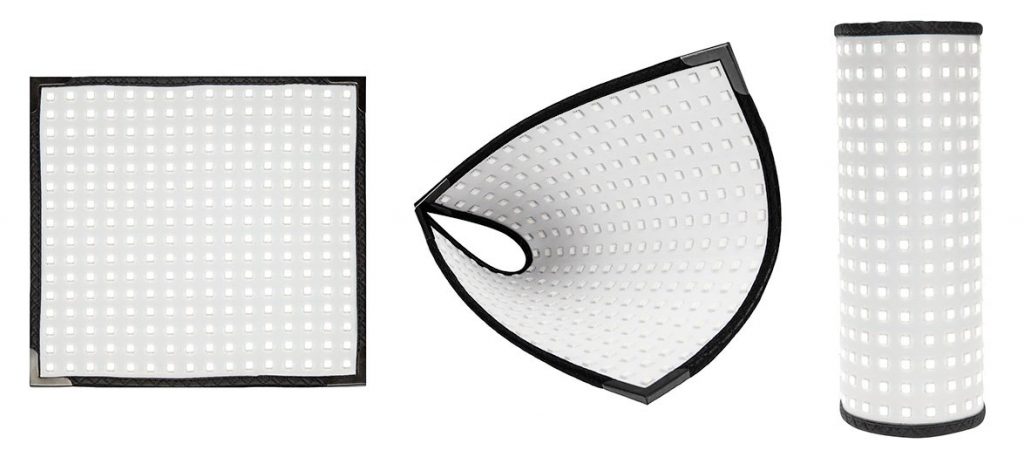
It turns out it’s the little details that have held back many buyers from handing over their wallets (and their current lighting kits). But mostly the cost. With a diffusion screen and a battery, you're looking at over $1000 for a 1x1 flex light. Which is maybe not that much for a traditional light panel with heavy duty housing and advanced features, but it's harder to swallow when you know that a few ribbons of high CRI LEDs can be bought for $25.
Fast forward a few years later, and now there’s Chinese-made Flex Lights that sell these high-CRI LED ribbons in flexible housings made for photographers and videographers. Some even look remarkably like the original Aladdin and Westcott Flex. Sure, maybe they don't have the build quality of an authentic Flex light, but they're much more affordable. So we decided to buy a few of them to try them out. And to our surprise, they’re actually pretty good. So now, the details.
Flex Light: What it is and what it should be
If you’ve followed this site for a bit, you may have read about our attempt to make a DIY Flex Light earlier this year. We figured it was worth a shot, even if we failed, just to learn a little about DIY electronics.
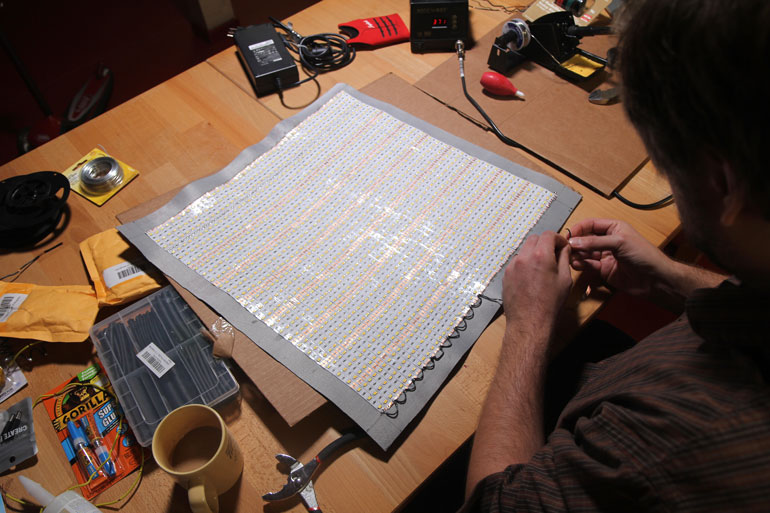
Our attempt at a DIY flex light
Well, it turns out we don’t have the gift of soldering, so after several attempts, we failed. And it ended up costing quite more than we figured for all the supplies that we didn’t already have, like a temperature controlled soldering iron, the various heat-resistant glues, faux leather, and more LED ribbons than we initially thought we needed.
In the end, we realized we were spending too much money and time on the project, so we decided to scrap it. But the bigger lesson was that even if the DIY version worked, we really wouldn’t feel comfortable depending on it for paid gigs. So we decided to put away our DIY electronics dreams and just stick to buying lights that are manufactured and ready to use.
A few months later, we started hearing about Chinese-made flex lights on Alibaba, Aliexpress, and even Amazon. They looked pretty decent, but knowing that they were probably a bit underpowered compared to the original flex lights, we weren’t as interested in the 1x1 versions. We waited for bigger mats - we wanted a manufactured version of the 24x18 inch version we tried to DIY, or larger, like the Westcott 2x2 mat. (More on that in a bit..)
At NAB, we got to see where the flex light industry has been moving toward since its introduction a few years ago. And to be honest, most of the professional grade flex lights out there are kind of veering away from the whole reason why we were enamored with flex lights in the first place - their size and weight.
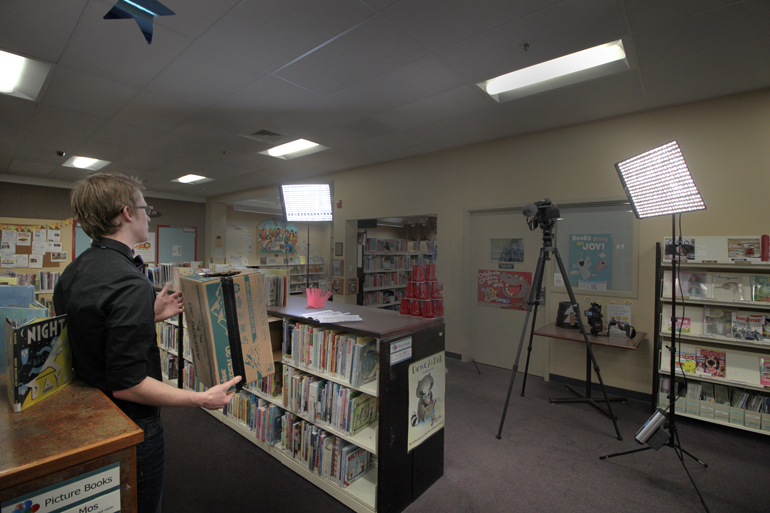
We've been using our recommended flex lights in place of traditional panels
For us, we’re not that interested in wrapping a flex light around a pole, or sticking it inside a lampshade, or any of the other creative uses for it that are mostly marketed toward narrative filmmakers. We simply want one because they take up no space or weight during travel. Even if we only attached them to a light stand for use during interviews, we would be happy to chuck all our other lights when we’re traveling on documentary shoots.
The secondary use for flex lights is to be able to tape them onto walls or ceilings when we need a simple B-roll light off frame. There are plenty of times where we’re shooting a subject working on something, and instead of setting up complicated lighting arrangements, it would be so nice to just tape a flex light directly above the subject, or against an object or wall nearby.
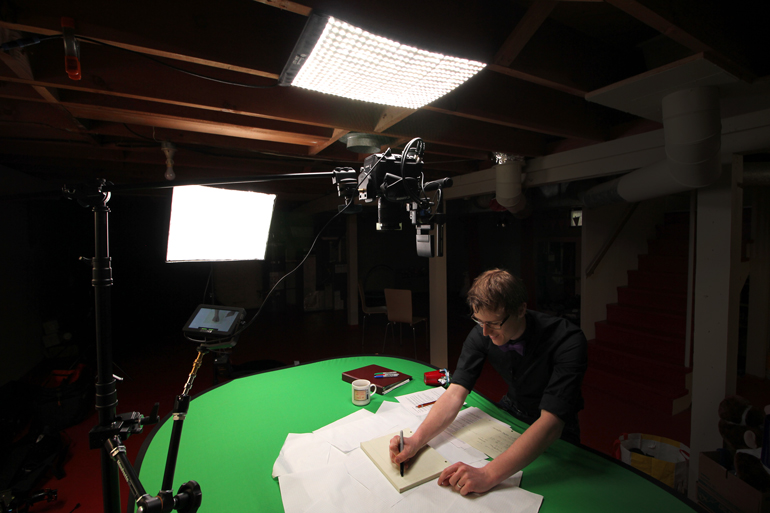
But for some reason the industry has not gone in that direction at all. Instead, we’re seeing flex lights being sold with accessories such as rigid frames and heavy-duty, solid metal housing, turning them into what look like traditional 1x1 panels.
We’re seeing flex lights marketed for their waterproof durability in extreme outdoor situations, rather than the fact that they are super convenient for most simple, indoor interviews and shoots. And we’re also seeing large multi-unit systems that enable you to build large sources of lights, using a series of 1x1 flex mats in a variety of configurations.
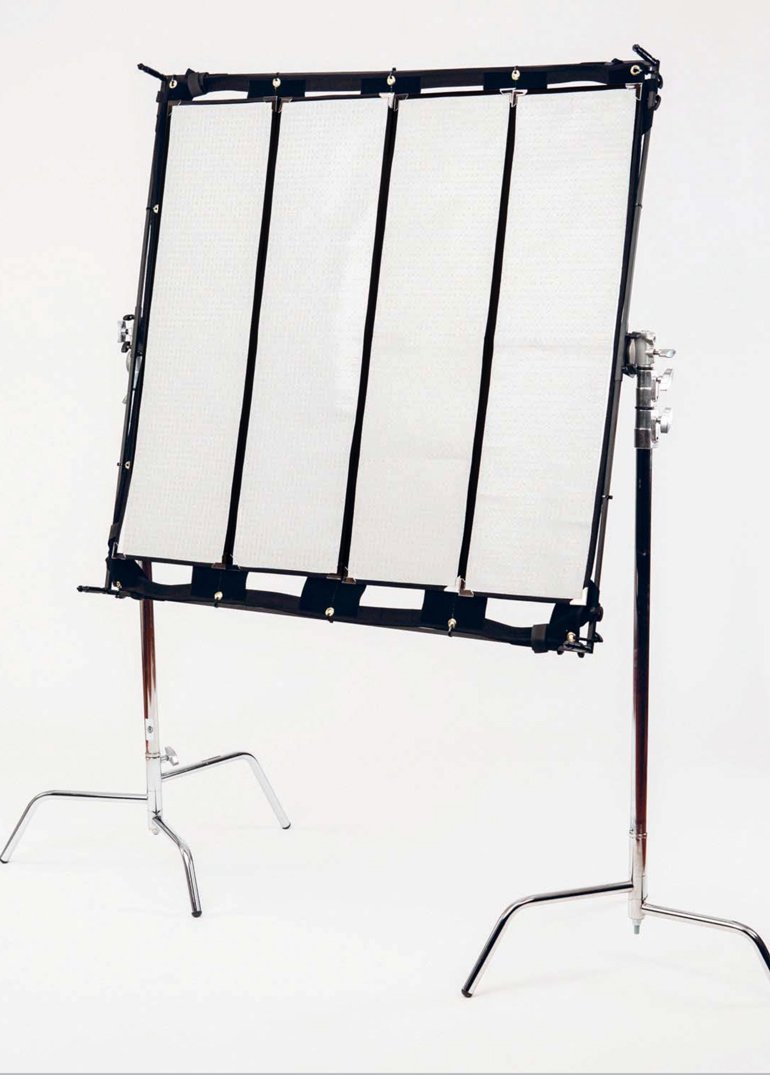
All of these applications are very interesting, and they do still take advantage of the flex light's portability, to some respect. But for the everyday videographer, the main issues with the original Flex light still haven’t been addressed, which would make them a no-brainer purchase for many of us.
First, the dimmer and power brick is still fairly bulky on all the flex lights out there. If you want to tape the light onto a ceiling, for example, you would need to have a long extension cable to ensure that the dimmer unit isn’t hanging in mid air. One of the reasons we were really interested in the DIY flex light is because the dimmer itself was about the size of a matchbox. The AC brick is still as big as any AC power unit out there, but you could place that far from the light itself.

But really it’s the battery issue that has prevented the flex light from taking off. None of the flex lights out there have a simple method of attaching a couple Sony NP batteries on the back.
They are tiny, cheap, and lightweight - the perfect companion to a flex light. But the only advertised battery option for flex lights out there are bulky and expensive V-mount and Anton Bauer batteries.
Actually, Brightcast/Kamerar initially offered a velcro Sony NP connection to the back of their flex lights, which was one of the main reasons they got a lot of attention.
And while it was still a little clunky, it was very close to what many people wanted. But for some reason, they’ve moved away from that battery back and toward the big battery bricks instead.
And then there are the softbox diffusion options. Again, for some reason flex lights have been paired with softbox diffusion systems that take away from the lightweight and thin nature of the flex light itself. Sturdy, dependable softbox diffusion kits are great, but if they take up more space than the light, and take more than a few minutes to setup, then they’re kind of missing the point.
And finally, as much as we like the 1x1 panel, flex lights allow us to think about bringing bigger lights around with us, like 1x2 and 2x2, without adding any more space. They can simply be folded or rolled up for travel, so why wouldn’t we want the bigger versions instead? A traditional 2x2 metal-frame light panel would be so heavy it would require a C-stand and sand bags.
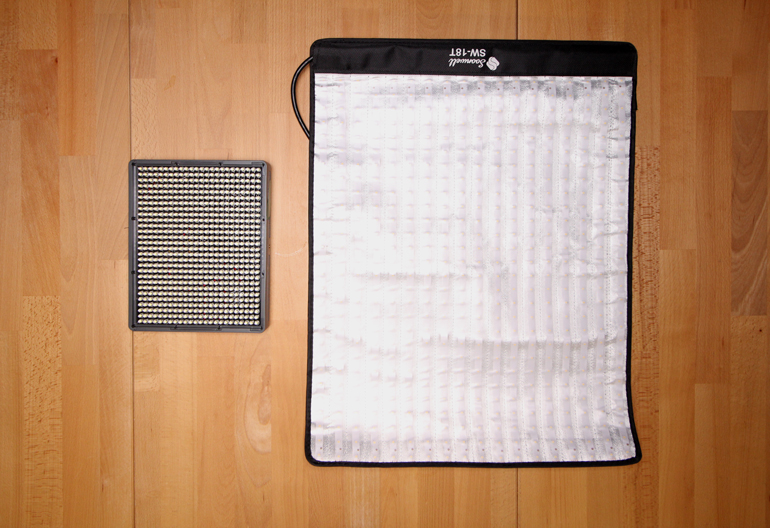
That’s why the large flex light is such an attractive product. It gives us something we can’t get otherwise. When you compare a flex light with dimmer and power brick, it ends up being heavier and more complicated than a simple Aputure Amaran 672 with a couple Sony NP batteries. But the size of the light is worth the added complexity.
One more point to consider. Most 1x1 flex lights offer around 250 LEDs in a variety of beam angles and wattage. The power output can vary quite a bit with those differences, but still, the number of LEDs is a good base to use when you’re shopping for lights. Comparatively, the Aputure Amaran 672W light has, you guessed it, 672 LEDs.
Both the Westcott Flex 1x1 Daylight Mat and the Aputure Amaran 672W lights claim around 2000 lux at 1 meter. The Amaran has a power draw of 45W, while the Flex has 55W, which makes sense since the Amaran takes two Sony NP batteries and the Flex requires an additional battery brick to power without AC. As for beam angle, the Flex claims 140-360 degrees, while the Amaran 672W is about 75 degrees.
At any rate, the point is, here are two lights with roughly the same photometric output numbers, but one has 256 LEDs and one has 672 LEDs. So that’s another thing to consider when we’re looking at Flex lights. What’s more important, a super bright mat with a big dimmer plus battery box, or a compact package with less output per LED, but ultimately more portable?
Flex Light Alternatives
At last we get to the Chinese-made flex lights. For those looking at 1x1 alternatives, the most popular versions have been:
1x1 and 1x1.5 Flex Lights
- Kamarar/Brightcast V15 Flexible Bicolor LED Panel - this was the first knockoff flex light, so it's a little more developed and has unique features like a battery plate that velcros on the back of the light. They used to include a Sony NP battery plate, but now it's only the larger battery bricks like V-mount. It's also pretty expensive, and at the price it's probably better to go with a real Westcott Flex.
- Samtian FL-3030 - the same light also sells under different names, such as Eachshot, Andoer Travor, Fositan, and Neewer. This is the closest thing to a copycat of the Flex, at a fraction of the price. But of course, don't expect the best quality.
- Samtian FL-3030A - the same light, but bi-color. Also sells under Andoer Travor FL-3030A, and Fositan FL-3030A. Bicolor is convenient, but with only 256 LEDs total, you lose a lot of output when the LEDs are split between tungsten and daylight.
- Falcon Eyes RX-12T - this is a smaller version of the flex light we're using, under a different brand. It has 280 LEDs at 34W. It also sells as a kit with a softbox, which we highly recommend (see below for more on that).
- Soonwell FB-151 - Since our initial review, Soonwell, our recommended flex light, has updated their original 12x18 daylight flex light, which was similar to the above Falcon Eyes RX-12T. The FB-151 has a better light stand mount, AC adapter, power draw, and overall build quality. We recommend this version if you want the smallest, most affordable flex light.
But like we wrote above, we are interested in the larger flexible LED mats, because they offer a unique large source of light that would otherwise be too bulky on a traditional panel. And also, more LEDs mean more output, for not much more cost, so we think the larger mats are a better bet. The sweet spot is a larger mat that doesn’t require a huge, bulky dimmer or power brick. Here are the popular ones.
1x2 Flex Lights
- Samtian FL-3060 - this also sells under different names, such as Andoer Travor. It's basically a 1x2, or around 12x24 inches, with 448 LEDs at 85W of power, with a 120 beam angle. It comes with a remote, carrying case, light stand adapter, and a diffusion frame and cloth. Overall it's a much better deal, with twice the output as the FL-3030 without adding much to the size, since the accessories are the same, and the mat can be rolled up or folded.
- Andoer Travor FL-3060A - this also sells under Fositan. It's exactly the same light as the FL-3060 except bicolor. So with the same amount of LEDs and power supply, you're getting half the output in daylight. But bicolor is pretty convenient. While we wouldn't do bicolor in the 1x1 size, we would get it in this 2x1 size. Update: Fositan now has a second generationFL-1x2A bicolor light, although at the time of writing it was unavailable.
- Soonwell FB-21 - this is the newest and best version of an affordable 2x1 bicolor flex light out there. Soonwell has updated these lights in a number of ways and we hope to do a review of one soon.
Although we really like a 2x1 flex light, especially considering the price, there are a few things that kept us from buying one initially, at least before the Soonwell FB-21 was available.
Like the Westcott Flex, the diffusion cloth for the Samtian and Andoer Travor / Fositan lights attaches to a scrim frame, which takes a little time to setup. Not a big deal, but it still only sits an inch or less away from the LED face. So, it’s not that effective at spreading light. It’s probably easier to just velcro the diffusion cloth to the light and call it a day, if you want to cover up the individual LEDs for a little amount of diffusion.
Mostly, it’s the lack of a battery mount that makes the FL-3060 and FL-3060A a not particularly attractive option for us. You need to have a battery option for flexible lights - otherwise what's the point? The build quality, remote, and overall crazy low price makes one of these a low-risk purchase even if you don’t end up using it all that often. But for our buck, the Soonwell FB-21 is a better investment if you want the 2x1 size.
Soonwell FB-215 - 2x1.5 Flex Light
Finally we get to the lights that we bought and the one we recommend today.

We originally bought a couple of the Soonwell SW-18T, which is a daylight mat roughly 18x24 inches across, and only about 10mm thin. It draws 62W of power, with an advertised 504 LEDs at a very wide beam angle. It claims 2500 lux at 1 meter, with a CRI rating of 95.
More recently, Soonwell has updated the 18x24-inch model and it's now sold as the Soonwell FB-215 (indicating 2 x 1.5 feet). The new version is bicolor only, but it offers much more output without the bulky AC adapter of the original bicolor version.
It has a much less rigid frame than other Flex lights, which we actually like, because it’s a lot easier to roll up tightly for travel, and as we mentioned before, we’re not really going to wrap this around a light pole or something.
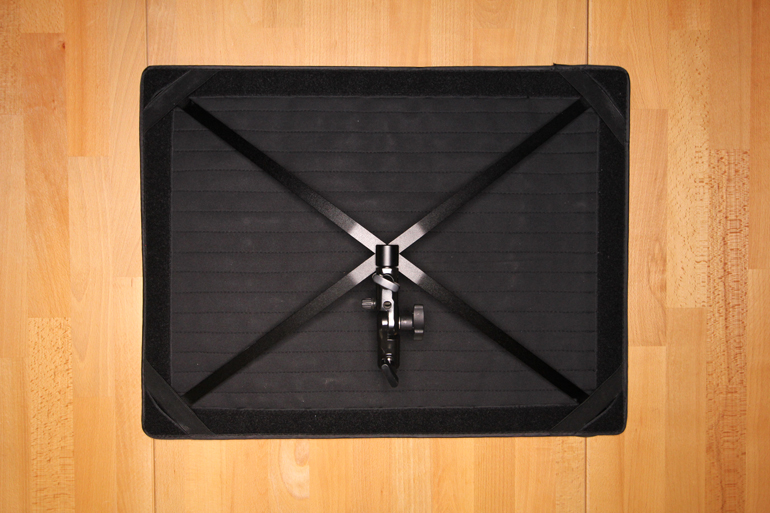
Because it’s not very rigid, you can’t simply clip it onto the top of a light stand like you could with other flex lights, so you need to use the included support bracket with a baby stud light stand adapter built in.
It’s not bad, perhaps a little better than Westcott’s original support bracket, and it’s quick and easy to setup. But the light stand adapter rotates freely, and is not tightenable, which means sometimes the light tilts a little toward the side where the AC adapter plug is pulling on it.
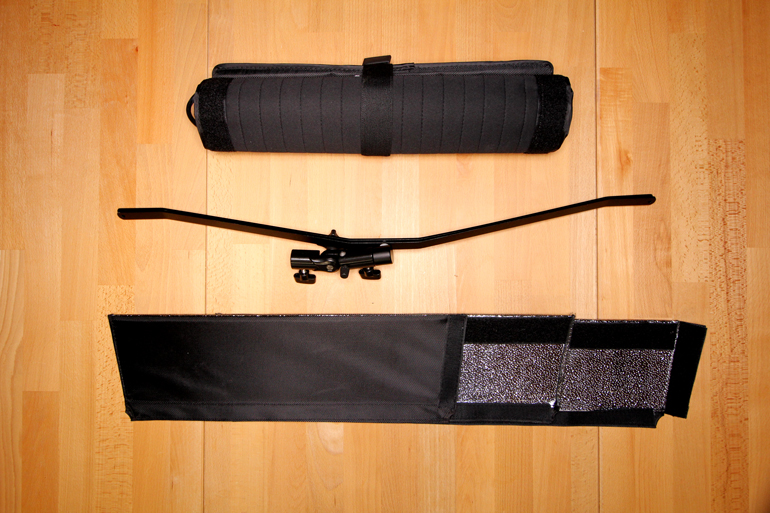
The support bracket is a single solid piece, and it's as long as the flex light is diagonally and doesn’t break down into smaller pieces. Overall, it works, but we’ll be looking at a simpler DIY solution to mount this to a light stand in the future. (Update: the newer versions now have a collapsible bracket that's better for traveling).
Speaking of diffusers, one of the things we most like about this light is the custom softbox diffuser, which was originally sold as a separate piece or as a kit (here's Falcon Eyes' version of the softbox). The newer Soonwell flex lights now include the softbox as standard with any kit.
It is super easy to velcro on, does a good job of diffusing the light, and what we like best about it is it makes this affordable flex light look like a decent 18x24” panel light to the client or subject you’re interviewing.
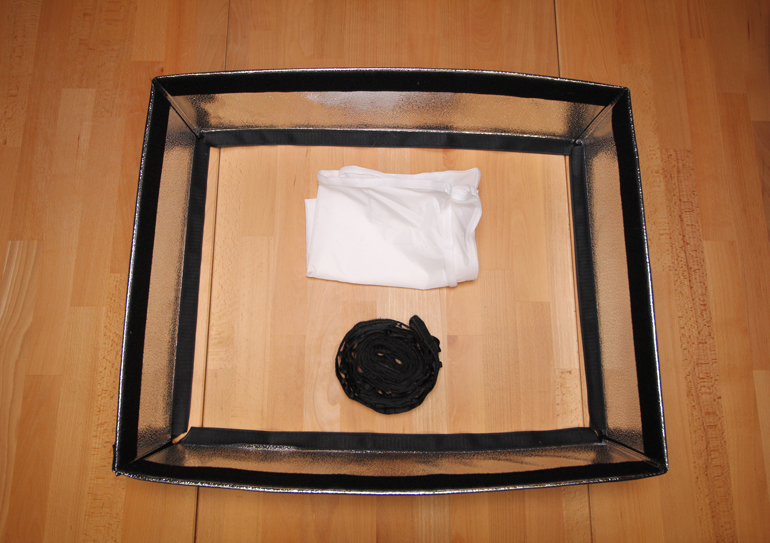
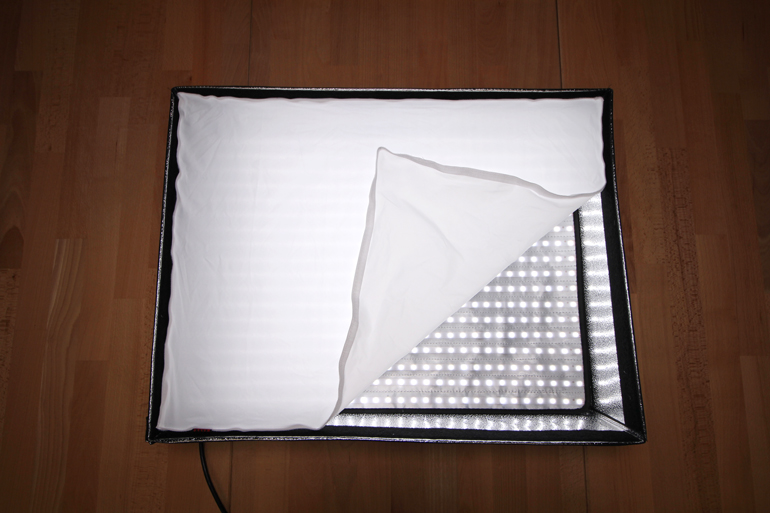
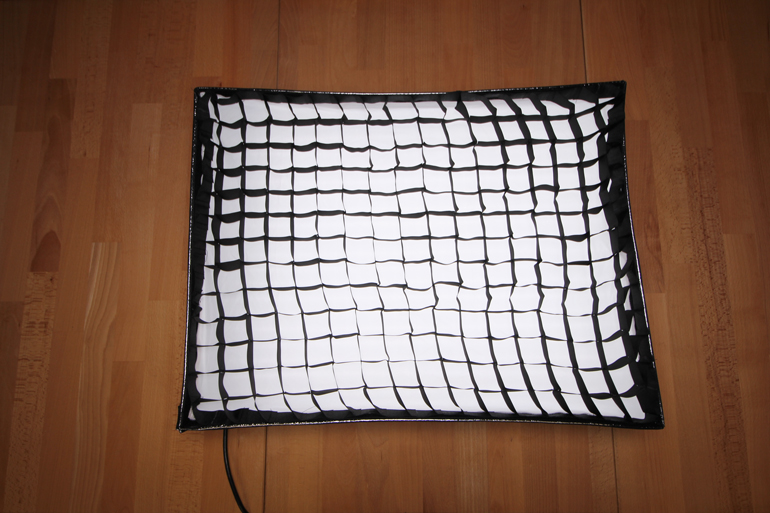
The softbox also comes with a honeycomb grid, which is a nice bonus, but we’re not sure if it makes that big of a difference in controling spill. There’s also an interesting looking half-sphere diffuser in a different package, but ours didn’t come with one, so we can’t comment on how good it is.
Our one complaint about the softbox is it doesn’t fold up as compactly as we’d wish - it ends up being longer than the 24-inch side of the flex light. Folded up, the softbox takes up a lot more space than the flex light itself, which is not very convenient for packing.
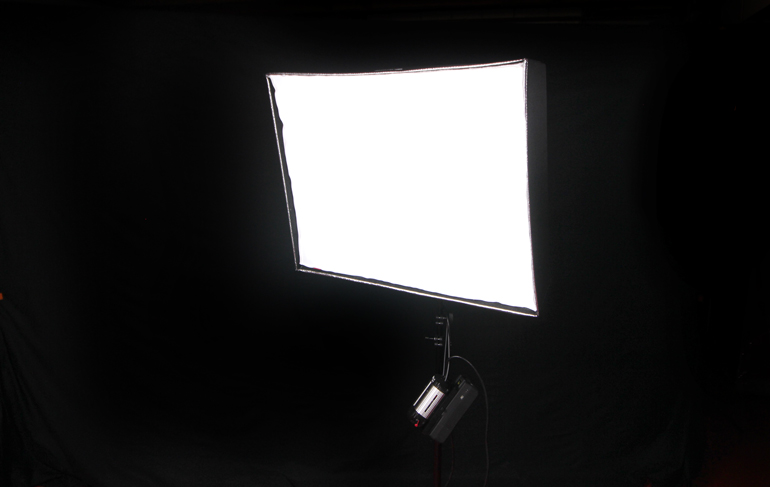
Finally, the key to our choosing this light over the others is the dimmer box is really small, and it includes a V-mount tray for batteries. This really is the most compact battery solution we’ve seen for flex lights yet, and even with a 160W V-mount it’s still very portable and convenient. The dimmer box includes a little plastic hook that makes it easy to hang it from a light stand knob.
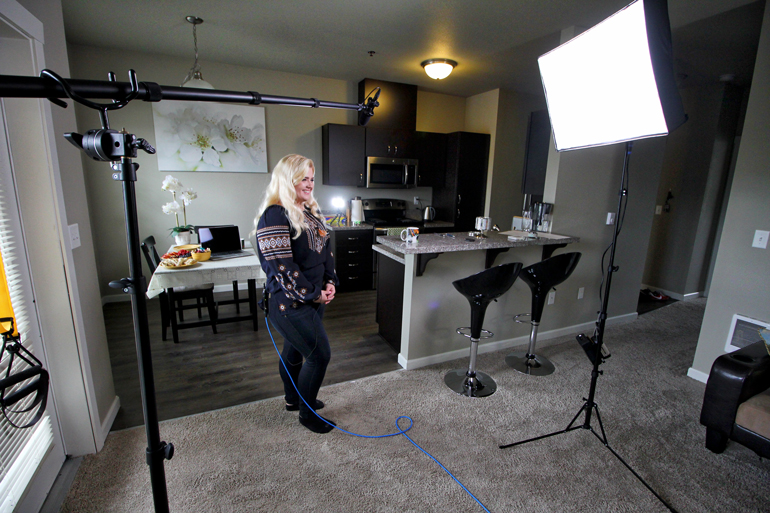
Our recommended flex light on an interview
We’ve been using this light on a variety of shoots, and it’s actually pretty good. With the softbox on, it ends up being a pretty large source of soft light that makes for a good key light. We think the color and output matches well with daylight coming through a window.
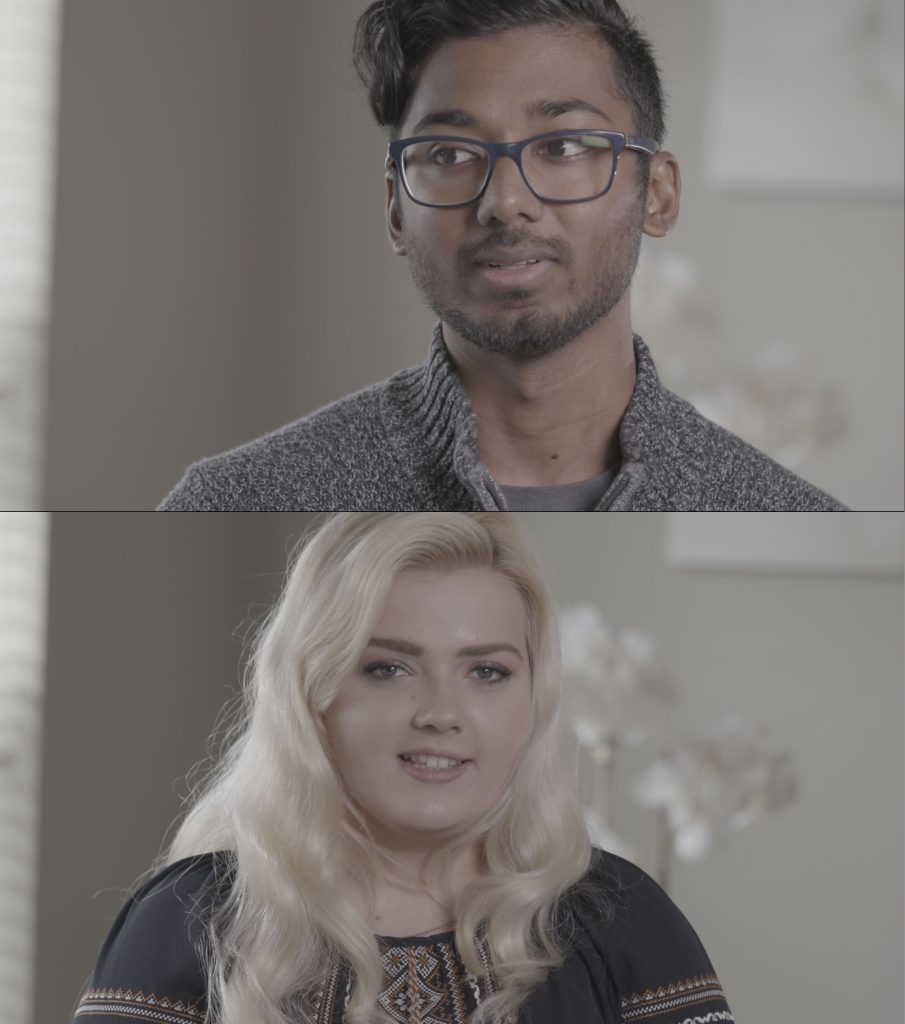
Ungraded Canon C300mkII C-Log3 - one RX-18T flex light as key
We’ve also used the light as we originally dreamed about using a flex light for, to mount on a wall when we need a simple light for B-roll, or to hang from the ceiling when we want an overhead light.
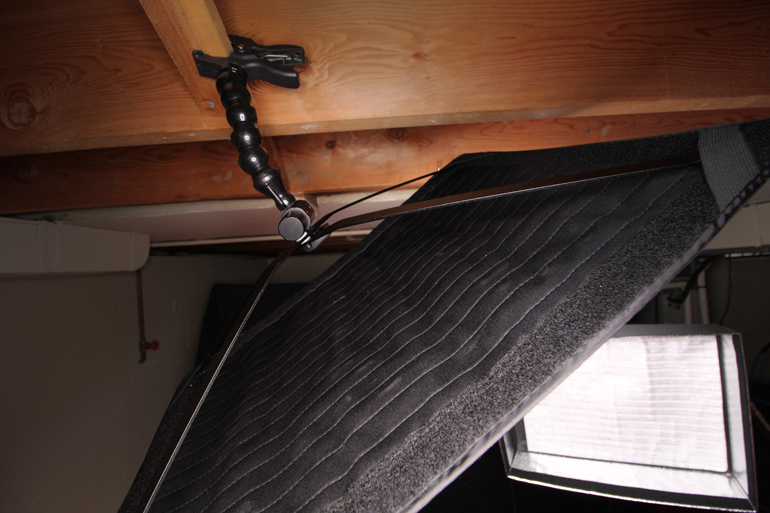
We actually bought two of the 18x24 lights, and one of them ended up having a few missing LEDs on one strip. The company we purchased from - Soonwell - sent us a replacement strip, along with video directions on how to solder it together. But knowing our shoddy soldering skills, we’d rather have a functional light with a few less LEDs, than have to send the whole thing back for a replacement after a botched soldering job.
Apart from the missing LEDs on our one unit, just about the only complaint we have about the SW-18T is we wish it was a little brighter for a 18x24 light. The Westcott 2x2, for example, has twice the amount of LEDs, at 3x the wattage, so it has about 3x the output. But it's also 10x the cost.
Compared to a typical 1x1 panel, the fact that the SW-18T’s beam angle is wide and it’s a larger source of light means you don't need to heavily diffuse it to make it softer. By the time you diffuse a standard 1x1 panel through a 5-in-1 portable diffuser, you've lost half its light output.
Thankfully Soonwell's newer FB-215 light - an update to their original 18x24-inch flex - has a lot more output without sacrificing portability. And it's bicolor.
Soonwell Bicolor 18x24 flex light
After we bought a couple of the Soonwell SW-18T daylight flex lights, we followed up and bought their bicolor version, now called the FB-215. It features the same overall amount of LEDs but with a higher power draw of 100W. Even at 5600K, the light is actually brighter than the original daylight-only version, because of the larger power draw.
At the time when we bought the bicolor version, everything apart from the power supply was exactly the same as the SW-18T. But the original dimmer box was gigantic. It’s about 3X the size of the SW-18T’s dimmer box.
The light is bicolor from 3000K-5600K, which can be adjusted via touchscreen on an LCD screen, along with brightness controls. There’s also wireless control via DMX.

The original SW-18T dimmer and V-mount battery on the left, and the original SW-18TD dimmer on the right.
Even before looking at brightness levels, we thought the SW-18TD’s dimmer unit made it a lot less convenient for lightweight travel. The AC adapter is also bigger than the one included with the SW-18T.
Side by side, when we turn on both the SW-18T and SW-18TD to full power daylight, their outputs don’t look that different. The LEDs on the SW-18TD are actually slightly bigger, and with the higher power draw from the dimmer unit, the output is higher, even with only 252 LEDs activated, compared to all 504 LEDs on the SW-18T.

We also connected the bigger dimmer onto the daylight RX-18T to see what would happen (we’re crazy like that). The color switcher turned on alternating rows of LEDs, just like on the bicolor version. At somewhere in the middle of the color dial, both rows were on, and perhaps they were slightly brighter than with the smaller dimmer unit, but we couldn’t tell. So, interesting experiment but not that useful.
The Updated Soonwell FB-215 - Bicolor, Brighter, With A Small Dimmer Unit
Thankfully if you're just starting to shop for a flex light today, your decision is a little easier to make. When we first started traveling with both the daylight and bicolor versions, we had to seriously consider whether we had enough room for the large dimmer unit.
But now with the Soonwell FB-215 updated 18x24 flex light, the dimmer box is quite small and no longer an issue. So now you can get all the advantages of bicolor and a brighter output - even in daylight - without the bulk of the dimmer and AC unit, or the long bracket arms.
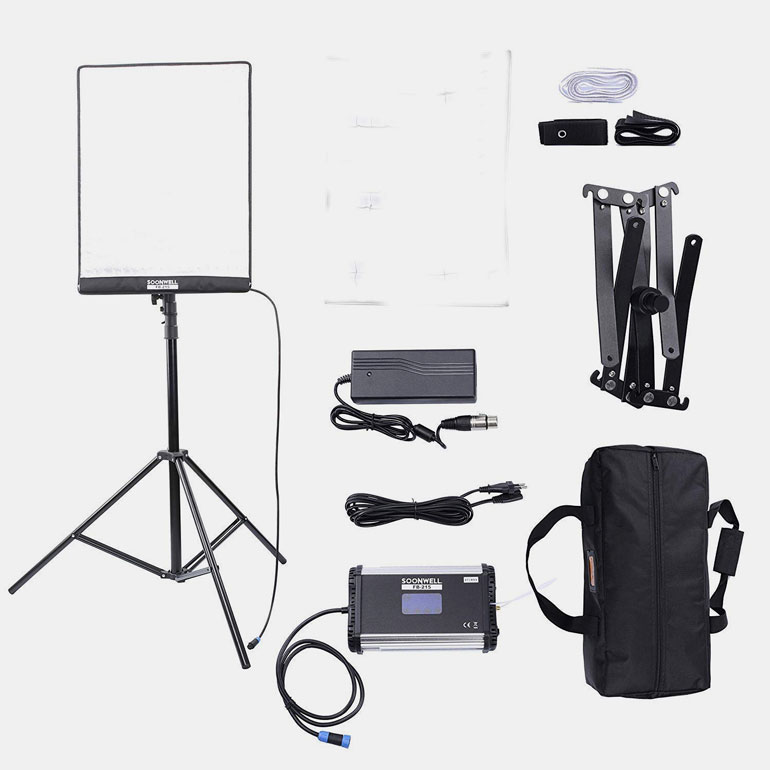
Conclusion
We’ve been wanting to get into Flex lights for a while now, but features like bulky dimmer and power bricks, no battery options, and the overall cost kept us from buying into the flexible mats. Over time, the flex light industry has moved farther and farther away from embracing its simple, lightweight nature, and instead it’s moving into more complicated framing units that require multiple flex lights as their source.
So when the Chinese-made lights became available, we started watching for a good mix of price and features that would enable us to use the flex lights as we hoped to use them: as simple, lightweight, portable interview lights, as well as B-roll lights we could tape onto walls and ceilings.
The Soonwell FB-215 is currently the best bet for these features, as they are larger mats that are incredibly light and easy to roll up, they have easy battery attachments, their custom soft boxes make them more attractive as key lights, and they’re really really cheap.
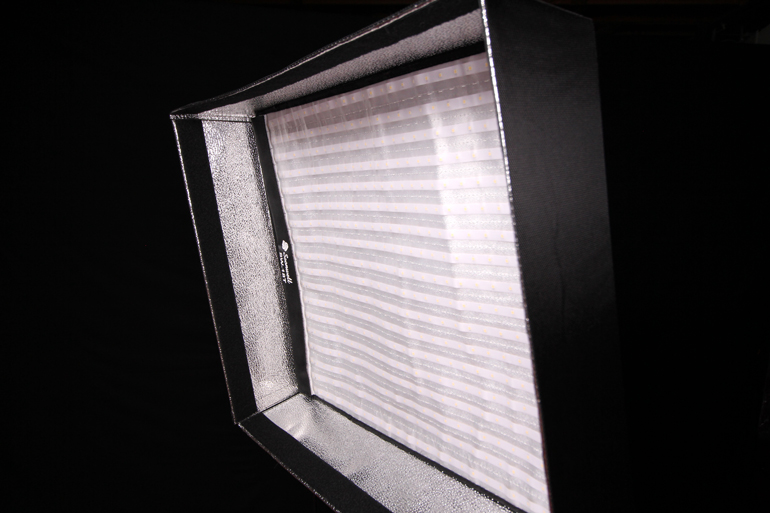
But of course, when it comes to lights, you get what you pay for. Sometimes that means broken or faulty products (like our missing LEDs), sometimes that means hard to understand marketing or product information that gets lost in translation, and of course, it's not convenient to ship a light to China for repair or replacement, if you ever need to.
In the end, we can live with the flaws, and we also know these lights aren’t much more than manufactured versions of our DIY Flex Light - LED ribbons soldered together and paired with off the shelf power. But we believe these lights will be dependable enough to take out in the field for at least a year, if not more, and for the price, that’s worth it. (Update: we've used them for several years now and they're still going strong.)
We’ve used these lights on interviews and for product photography, and we've traveled with them to Alaska on a variety of remote shoots. We’ve also taped them to a wall and ceiling in a pinch. It’s kind of exciting to know we have these in our tool bag when we need them.
Have you bought into an alternative Flex Light? Send us an email and let us know! We’d love to hear your thoughts, and maybe publish them below.
Finally, here's a video demonstration of the Soonwell flexible LED lights:
